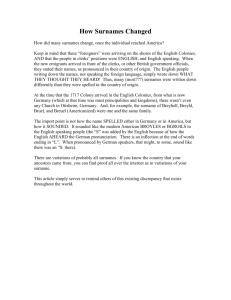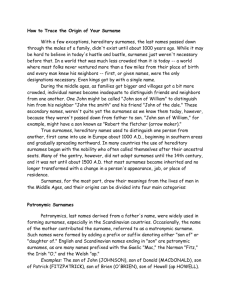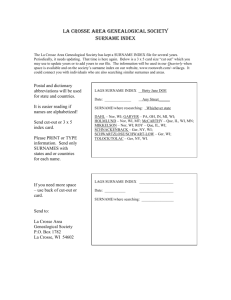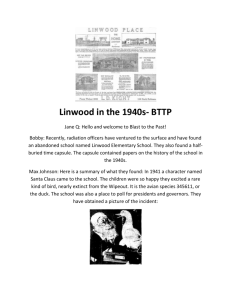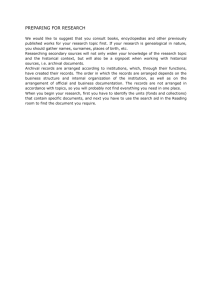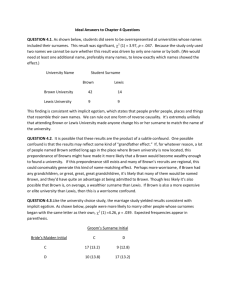Anatomy of a Surname - Faculty Website Index
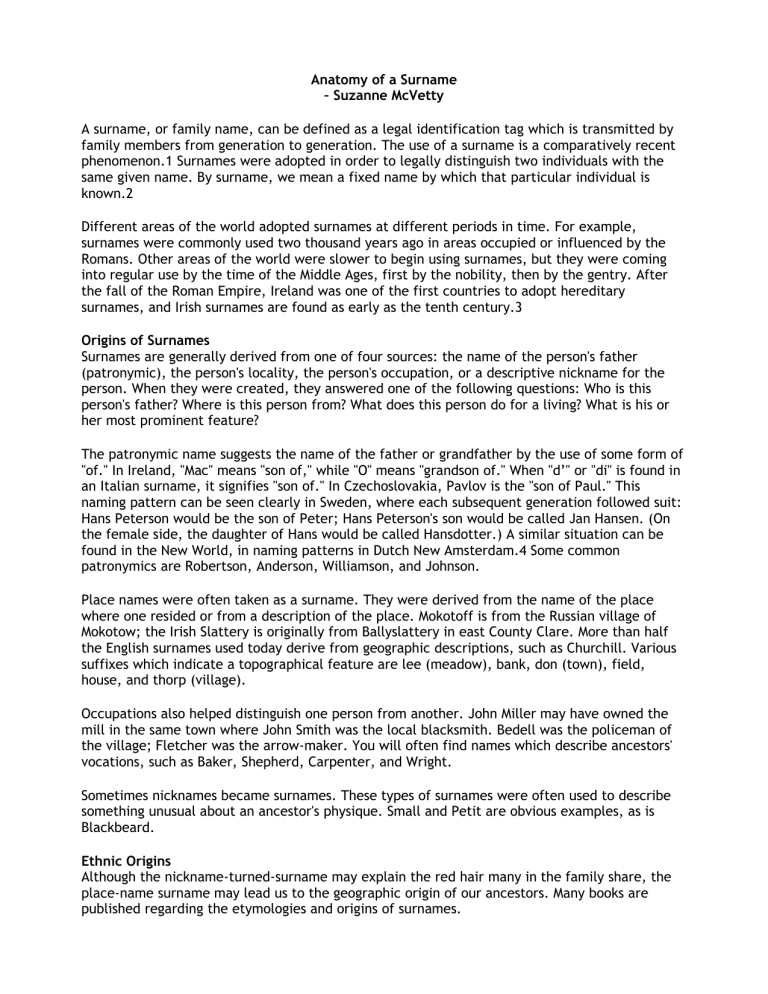
Anatomy of a Surname
– Suzanne McVetty
A surname, or family name, can be defined as a legal identification tag which is transmitted by family members from generation to generation. The use of a surname is a comparatively recent phenomenon.1 Surnames were adopted in order to legally distinguish two individuals with the same given name. By surname, we mean a fixed name by which that particular individual is known.2
Different areas of the world adopted surnames at different periods in time. For example, surnames were commonly used two thousand years ago in areas occupied or influenced by the
Romans. Other areas of the world were slower to begin using surnames, but they were coming into regular use by the time of the Middle Ages, first by the nobility, then by the gentry. After the fall of the Roman Empire, Ireland was one of the first countries to adopt hereditary surnames, and Irish surnames are found as early as the tenth century.3
Origins of Surnames
Surnames are generally derived from one of four sources: the name of the person's father
(patronymic), the person's locality, the person's occupation, or a descriptive nickname for the person. When they were created, they answered one of the following questions: Who is this person's father? Where is this person from? What does this person do for a living? What is his or her most prominent feature?
The patronymic name suggests the name of the father or grandfather by the use of some form of
"of." In Ireland, "Mac" means "son of," while "O" means "grandson of." When "d’" or "di" is found in an Italian surname, it signifies "son of." In Czechoslovakia, Pavlov is the "son of Paul." This naming pattern can be seen clearly in Sweden, where each subsequent generation followed suit:
Hans Peterson would be the son of Peter; Hans Peterson's son would be called Jan Hansen. (On the female side, the daughter of Hans would be called Hansdotter.) A similar situation can be found in the New World, in naming patterns in Dutch New Amsterdam.4 Some common patronymics are Robertson, Anderson, Williamson, and Johnson.
Place names were often taken as a surname. They were derived from the name of the place where one resided or from a description of the place. Mokotoff is from the Russian village of
Mokotow; the Irish Slattery is originally from Ballyslattery in east County Clare. More than half the English surnames used today derive from geographic descriptions, such as Churchill. Various suffixes which indicate a topographical feature are lee (meadow), bank, don (town), field, house, and thorp (village).
Occupations also helped distinguish one person from another. John Miller may have owned the mill in the same town where John Smith was the local blacksmith. Bedell was the policeman of the village; Fletcher was the arrow-maker. You will often find names which describe ancestors' vocations, such as Baker, Shepherd, Carpenter, and Wright.
Sometimes nicknames became surnames. These types of surnames were often used to describe something unusual about an ancestor's physique. Small and Petit are obvious examples, as is
Blackbeard.
Ethnic Origins
Although the nickname-turned-surname may explain the red hair many in the family share, the place-name surname may lead us to the geographic origin of our ancestors. Many books are published regarding the etymologies and origins of surnames.
The importance of a surname in ethnic origin research is that it may give us a place to begin our research overseas if we have not been able to find any other indication of place of origin using
American records. Looking for the geographic origin of a surname is really a last-ditch effort, since, in many cases, the place of surname origin dates from an earlier time and may not be the place our immigrant ancestors originated. However, knowing the origin of a surname can narrow the search a bit.
From MacLysaght's books on Irish surnames [see sidebar], we learn that Slattery comes originally from east County Clare, on the west coast of Ireland. The name has since spread to neighboring counties and is prominent in western Ireland. Using Griffith's Valuation, a land tax used as a substitute for missing nineteenth-century census records, the name Slattery is found most often in County Limerick, neighboring County Clare, and, to a lesser degree, in counties Kerry and
Cork.
While living in Ireland, I was asked by a hotel manager in Dublin if I was one of the Slatterys of
Cork, to which I replied, "No, my family came from Tralee in County Kerry." He then asked, "Are you related to Tom Slattery of Slattery's Travel in Tralee?" I responded enthusiastically that I was: although my great-grandfather left Tralee for New York in 1882, distant cousins still reside in Tralee four generations later. The family was traced to the late 1700s in Tralee, quite a distance in time for Irish Catholic families.
John Hennessey explains how you can narrow a search for your ancestors in his article
"Probability Analysis and the Ancestral Place of Origin" in the National Genealogical Society
Quarterly. In his case study, Hennessey cross-checked both his grandparents' surnames in
Griffith's Valuation and in the country-wide surname indexes. Knowing only that they lived
"somewhere between counties Cork and Kerry" in Ireland, Hennessey was able to narrow the surname search to the civil parish of Eveleary, where he found their marriage record of 23
February 1899 in the Catholic church of Inchigeelah.
Knowing the history and social customs of an ancestor's native country can prove indispensable in locating the place of origin. Understanding that the Irish historically have had a close connection with the land is key to using a surname's place of origin to locate the family. Kevin Whelan, a noted history professor in Dublin, has studied the Wexford area of his ancestors using land, estate, tax, census, and church records of the area from the eighteenth century to the present.
He has found that the Irish families who held title to large estates before the English confiscated the land in the 1700s can often be traced today to within ten miles of the original holding.
In some countries, just the formation of a surname can lead to a place of origin. For example, often the geographic features of a country-mountain ranges, rivers, swamps-kept some groups of people separated and others linked together, and this shows in the common naming patterns which can be found in a region. In Italy, for instance, names with the form "casa" (meaning
"house") are found predominantly in the Lombardy region. Nine out of ten family names in
Lombardy end in the letter "i," while many in southern Italy end in "o." The prefix "Dell" or "Della" comes from central and northern Italy; "Li" is found primarily in Sicily.
Often the place where a country's invaders settled created regional surname patterns. "Fitz" is of
Norman origin, as in Fitzpatrick and Fitzgerald, and can be found in the areas in Ireland where the Anglo-Norsemen were established. "Acco" is Celtic in origin, and names using this suffix are often found in the Piedmont and Friuli-Vidracco areas of Italy. "Emi" is an Arabic form, and surnames in Sicily use this ending.
Jews from eastern Europe (Sephardic) often took the names of places they lived or the names of cities from which they emigrated, such as Mannheim, Ginsberg, or Lipschitz. German Jews
(Ashkenaim) commonly used combinations of beautiful words for surnames, such as Goldstein
(gold stone) and Blumberg (flower mountain).
Invasion by a foreign power sometimes caused changes in surnames. Foreign invaders often used language to control the population by changing the official language of the invaded country.
Many surnames were then written phonetically in the newly sanctioned language, which dramatically changed their spellings and created many spelling variations. When the English overran Ireland after the 1600s and made English the legal language of the land, Gaelic surnames were either Anglicized or translated into English. For example, today there are thirty-eight variations of the Anglicized name MacEnaney. Of course, the lack of fixed spelling to begin with, combined with general illiteracy, also contributed to the corruption of surnames.
If, after all research avenues in North America are exhausted, you are still no closer to finding your ancestor's place of origin, you can use surname source books to help learn where the family may have originated. Making the connection between foreign records of people with your last name to your immigrant ancestor may be impossible, but if the name is unusual and is used only by people of a particular place, knowing the surname's place of origin may open records that will link your ancestors with their foreign cousins, which is a good starting point. The genealogist
Gary Mokotoff has located, in over fifteen countries around the world, nearly one thousand descendants of his great-great-great-grandfather, who was the first person named Mokotoff and came from the Mokotow area of Poland.
Notes
1. Fucilla, Joseph Guerin. Our Italian Surnames. Baltimore: Genealogical Publishing Co., 1987.
2. Pine, L. G. The Story of Surnames. Rutland, Vt.: Charles E. Tuttle, 1967.
3. Smith, Elsdon C. The Story of Our Names. New York: Harper & Brothers, 1950.
4. Bailey, Rosalie Fellows. Dutch Systems in Family Naming: New York, New Jersey. NGS
Genealogical Publications No. 12. Washington, D.C.: National Genealogical Society, 1954.
General Surname Information
Pine, L. G. The Story of Surnames. Rutland, Vt.: Charles E. Tuttle, 1967.
Smith, Elsdon C. The Story of Our Names. New York: Harper & Brothers, 1950.
Irish Surnames
MacLysaght, Edward. Irish Families: Their Names, Arms, and Origins. Dublin: Hodges & Figgis,
1957.
_____. A Guide to Irish Surnames. Baltimore: Genealogical Publishing Co., 1964.
_____. Supplement to Irish Surnames. Baltimore: Genealogical Publishing Co., 1969.
Woulfe, Rev. Patrick. Irish Names and Surnames. 1923. Reprint. Baltimore: Genealogical
Publishing Co., 1993.
Matheson, Sir Robert E. Special Report on Surnames in Ireland. Dublin: Alex. Thom & Co., 1909.
O’Laughlin, Michael C. The Master Book of Irish Surnames. Kansas City, Mo.: Irish Genealogical
Foundation, 1993.
Dutch Surnames
Bailey, Rosalie Fellows. Dutch Systems in Family Naming: New York, New Jersey. NGS
Genealogical Publications No. 12. Washington, D.C.: National Genealogical Society, 1954.
Eastern European Surnames
Brandt, Bruce. Where to Look for Hard-to-Find German-Speaking Ancestors in Eastern Europe:
Index to 19,720 surnames in thirteen books, with historical background on each settlement.
Baltimore: Clearfield Press, 1993.
Jewish Surnames
Beider, Alexander. A Dictionary of Jewish Surnames from the Kingdom of Poland. Teaneck, N.J.:
Avotaynu, 1996.
_____. A Dictionary of Jewish Surnames from the Russian Empire. Teaneck, N.J.: Avotaynu,
1993.
Guggenheimer, Henrich W., and Eva A. Guggenheimer. Jewish Family Names and Their Origins:
An Etymological Dictionary. New Jersey: KTAV Publishing House, 1992.
English Surnames
Reaney, Percy Hide. A Dictionary of English Surnames. 3rd ed. Oxford: Oxford University Press,
1995.
French Surnames
Morlet, M. T. Les Noms de Famille. Paris: Librairie Guenegaud, 1977.
Italian Surnames
Fucilla, Joseph Guerin. Our Italian Surnames. Baltimore: Genealogical Publishing Co., 1987.
Scottish Surnames
Black, George F. The Surnames of Scotland: Their Origin, Meaning, and History. Reprint. New
York: New York Public Library, 1995.
Suzanne McVetty is a professional genealogist specializing in Irish, New York City, and Long
Island research. She is also a consultant, lecturer, and teacher of genealogy
